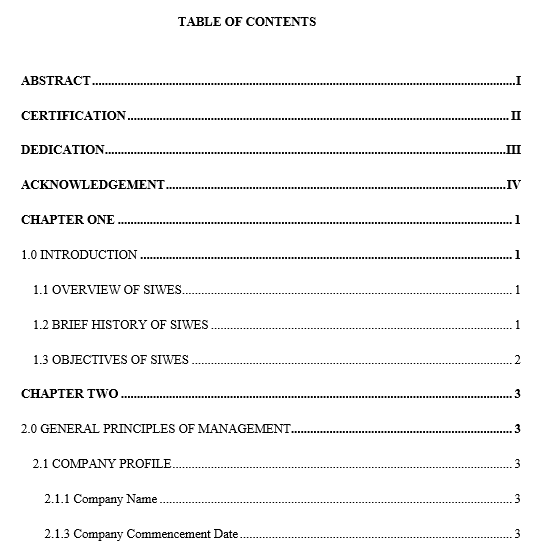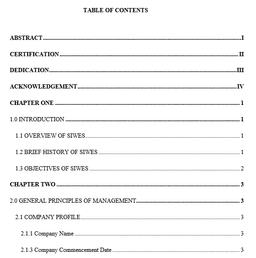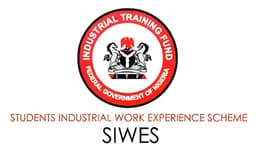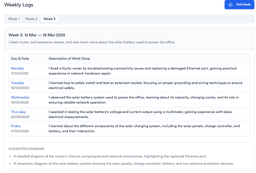SIWES Report Format in Nigeria: Complete Guide, Samples, Structure, and A Plus Writing Tips
Learn the complete SIWES report format used in Nigerian universities and polytechnics. Includes preliminary pages, chapter breakdown, samples, templates, formatting rules, grading tips, and A plus writing secrets.


Writing your SIWES report is one of the most important parts of your industrial training. Many Nigerian universities score the report between 30 percent and 40 percent of the total SIWES grade.
This is why a well written, detailed, and properly formatted SIWES report can determine whether you graduate with an A or a low grade.
This complete guide explains the standard SIWES report format used across Nigerian universities and polytechnics, with examples, templates, formatting guidelines, and writing tips that help students produce a professional grade SIWES report.
⚡ SIWES Tools for Students 🔥
Use our free AI-powered tools to make SIWES easier.
SIWES Report Generator — Generate a formatted SIWES report instantly.
https://report.monoed.africa
SIWES Logbook Generator — Create weekly logbook entries in seconds.
https://logbook.monoed.africa
SIWES / IT Placement Finder — Find verified SIWES & IT placement opportunities.
https://siwesfinder.monoed.africa
📙 Final Year Project Tools 🔥
FYP Report Generator — Generate full project chapters and citations.
https://fyp.monoed.africa
Project Topic Generator — Get supervisor-ready project topics instantly.
https://topics.monoed.africa
You will learn:
- The full SIWES report structure used nationwide
- Preliminary pages and what each one should contain
- Standard chapter breakdown with subheadings
- Real writing examples for each section
- Formatting rules examiners expect
- Common mistakes that reduce marks
- How to present tools, tasks, photos, figures, and tables
- APA, Harvard, and IEEE referencing samples
- A plus writing tips your supervisor silently looks for
Let us begin.
1. Standard SIWES Report Format in Nigeria
Almost every tertiary institution uses a similar structure. The format is divided into:
A. Preliminary Pages
B. Main Chapters
C. References and Appendices
Here is the recommended order:
- Title Page
- Declaration (optional)
- Certification
- Dedication
- Acknowledgements
- Abstract
- Table of Contents
- List of Figures
- List of Tables
- List of Plates or Pictures
- List of Abbreviations
- Main Report (Chapters One to Five)
- References
- Appendices
Each section below is explained with examples and templates.
2. Preliminary Pages Explained
These pages appear at the beginning of the report but are usually written last.
2.1 Title Page
Your title page must contain:
- Report title
- Your full name
- Matric or registration number
- Course and department
- Institution name
- Company name and location
- Duration of training
- Submission month and year
- Institution or department logo (if required)
Title Page Example
A Technical Report on Student Industrial Work Experience Scheme
Carried out at:
XYZ Technologies Limited, Lagos State
Submitted by:
Adeola Fatai Musa
Matric Number: CSC/2021/1042
Department of Computer Science
University of Lagos
Duration: July 2025 to December 2025
Submission Date: January 2026
2.2 Declaration (Optional)
A simple academic honesty statement.
Sample Declaration
I, Adeola Fatai Musa, declare that this SIWES report was written by me and is based on the activities and experiences obtained during my industrial training at XYZ Technologies Limited. All sources used have been acknowledged.
2.3 Certification Page
This confirms that you completed the training period.
It must include:
- Student name
- Matric or reg number
- Company name
- Supervisor signature
- Official company stamp
- SIWES coordinator signature
2.4 Dedication
Keep it short.
Example
This report is dedicated to God Almighty and to my parents for their support during my training.
2.5 Acknowledgements
Appreciate people who supported your training.
Include:
- Company supervisor
- SIWES coordinator
- HOD or lecturers
- Colleagues
One page is enough.
2.6 Abstract
The abstract is very important because examiners read it first. A poor abstract can reduce your score.
Write it last.
Abstract Example
This report summarizes the six month industrial training carried out at XYZ Technologies Limited, Lagos. During this period, I worked with the Web Development Unit where I gained skills in HTML, CSS, React, MySQL, and JavaScript debugging. I assisted in building responsive websites for clients and participated in database management tasks. Although there were challenges such as limited internet access and tight project deadlines, the training improved my technical skills, communication, teamwork, and problem solving abilities.
2.7 Table of Contents
Make sure the page numbers match the final layout.
2.8 List of Figures, Tables, Plates, and Abbreviations
Optional but recommended.
- Figures include charts and diagrams
- Plates include photographs
- Abbreviations help readers understand technical short forms
Example abbreviations:
HTML: HyperText Markup Language
ICT: Information and Communication Technology
3. Main SIWES Report Chapters (Standard Structure)
Most schools use a five chapter structure. Below is the most accepted format with variations for engineering, science, ICT, management, and polytechnic programs.
Chapter One: Introduction
This chapter provides context and background.
Recommended subheadings
- 1.1 Background of SIWES
- 1.2 Brief History of SIWES
- 1.3 Aims of SIWES
- 1.4 Objectives of SIWES
- 1.5 Relevance of SIWES to Your Field of Study
- 1.6 Purpose of the Training
- 1.7 Rationale for Choosing the Organization
Sample writing (short)
The Student Industrial Work Experience Scheme was introduced to expose students to practical knowledge in real workplaces. It helps bridge the gap between classroom theories and industry applications.
Read more on: How to Write SIWES Chapter One: Full Guide, Structure, Format and A Grade Example
Chapter Two: Organizational Profile
Explain the company where you trained. Include:
- 2.1 Company Background
- 2.2 Mission and Vision
- 2.3 Organizational Structure
- 2.4 Departments and Functions
- 2.5 Products or Services
- 2.6 Professional Ethics and Workplace Conduct
Organogram Tip
Use a simple chart showing:
Managing Director
⬇️
Operations Manager
⬇️
ICT Unit
⬇️
HR Unit
⬇️
Finance Department
⬇️
Technical Support Unit
Chapter Three: Training Activities and Practical Experiences
This is the most important chapter. Examiners focus heavily on this section.
Include:
- 3.1 Units or Departments Worked In
- 3.2 Daily or Weekly Tasks
- 3.3 Tools, Machines, Software or Equipment Used
- 3.4 Step by Step Explanation of Procedures
- 3.5 Projects You Contributed To
- 3.6 Skills Acquired
- 3.7 Workplace Safety Practices
- 3.8 Images of Work Activities (if allowed)
Example for ICT students
- Created website UI using HTML and CSS
- Debugged JavaScript based errors
- Assisted with MySQL database updates
- Participated in software testing
- Used Git for version control
Example for engineering students
- Operated drilling machine
- Prepared site measurements
- Assisted with wiring and panel installation
- Conducted equipment maintenance
Chapter Four: Challenges, Observations and Problem Solving
Include:
- 4.1 Challenges Encountered
- 4.2 How You Solved or Managed Them
- 4.3 Organizational Challenges You Observed
- 4.4 Suggested Improvements
- 4.5 Limitations
Be honest and specific.
Example:
Poor internet, shortage of tools, outdated machines, limited supervision.
Chapter Five: Summary, Conclusion and Recommendations
5.1 Summary of Training
5.2 Conclusion
5.3 Recommendations to:
- Company
- School
- SIWES body
- Future students
4. Formatting Requirements for SIWES Reports in Nigeria
These rules are common across most institutions.
- Paper size: A4
- Font: Times New Roman
- Font size: 12
- Line spacing: Double
- Alignment: Justify
- Margins: 1.25 inches (sides), 1 inch (top and bottom)
- Page numbers: Roman for front pages, Arabic for chapters
- Length: 30 to 50 pages
Some supervisors may ask for font size 13. Follow instructions from your department.
5. Referencing and Citation Guide
Your SIWES report is not complete without a reference list. Examiners want to see that you consulted textbooks, articles, or credible websites.
There are different citation styles, but most Nigerian schools accept APA, Harvard, or IEEE. Below are examples:
APA Style (7th Edition)
- In-text citation:
- One author → (Okafor, 2020)
- Two authors → (Okafor & Musa, 2021)
- Three or more authors → (Okafor et al., 2022)
- Reference List Examples:
- Book:
Okafor, J. A. (2020). Introduction to Database Systems. Lagos: University Press.
- Journal Article:
Musa, T., & Ibrahim, L. (2021). The role of SIWES in bridging theory and practice. Journal of Nigerian Higher Education, 14(2), 45–53.
- Website:
Siwes Beginner. (2021, November 10). SIWES Introduction, Aim & Objectives in Nigeria. https://siwesbeginner.com/siwes-introduction
Read more on: Ultimate Guide to APA 7th and MLA 9th Referencing for Nigerian Final Year Projects
IEEE Style
- In-text citation:
- Use numbers in square brackets → [1], [2], [3].
- Example: “SIWES helps to bridge theory with practice [2].”
- Reference List Examples:
- Book:
[1] J. A. Okafor, Introduction to Database Systems. Lagos: University Press, 2020.
- Journal Article:
[2] T. Musa and L. Ibrahim, “The role of SIWES in bridging theory and practice,” Journal of Nigerian Higher Education, vol. 14, no. 2, pp. 45–53, 2021.
- Website:
[3] Siwes Beginner, “SIWES Introduction, Aim & Objectives in Nigeria,” Nov. 10, 2021. [Online]. Available: https://siwesbeginner.com/siwes-introduction
Harvard Style
- In-text citation:
- One author → (Okafor 2020)
- Two authors → (Okafor & Musa 2021)
- Three or more authors → (Okafor et al. 2022)
- Reference List Examples:
- Book:
Okafor, JA 2020, Introduction to Database Systems, University Press, Lagos.
- Journal Article:
Musa, T & Ibrahim, L 2021, ‘The role of SIWES in bridging theory and practice’, Journal of Nigerian Higher Education, vol. 14, no. 2, pp. 45–53.
- Website:
Siwes Beginner 2021, SIWES Introduction, Aim & Objectives in Nigeria, viewed 20 August 2023, https://siwesbeginner.com/siwes-introduction.
6. Appendix Section
Include:
- Pictures
- Screenshots
- Codes
- Tables
- Sample forms
- Work schedules
- Certificates
7. Common Mistakes That Reduce SIWES Scores
Avoid:
- Copying other students reports
- Weak or vague descriptions of tasks
- Missing abstract
- No references
- No photos or evidence
- Poor grammar
- Wrong formatting
- Misaligned page numbers
8. How to Impress Your Supervisor and Get an A
- Your abstract should be strong and clear
- Use real photos from your workplace
- Be detailed when describing tasks
- Show evidence of learning new skills
- Highlight improvements you suggested
- Present a neat, well formatted document
- Use simple English that is easy to read
9. SIWES Report Templates (Copy and Use)
Template: Chapter Three Tasks Description
3.1 Unit Worked In
I worked in the Web Development Unit where solutions are provided for clients.
3.2 Tasks Performed
- Frontend design
- Database queries
- Debugging tasks
- Software testing
3.3 Tools Used
HTML, CSS, JavaScript, MySQL, VS Code, Git
Final Thoughts
Your SIWES report is more than just a formality — it’s proof that you have applied classroom knowledge in a real-world environment.
By following the official format, applying proper formatting rules, and being original in your descriptions, you’ll produce a report that not only earns you high marks but can also serve as a career reference in your CV.
👉 Keep it simple, structured, and authentic. That’s the winning formula for an A-grade SIWES report.
FAQs
Q1: How long should my SIWES report be?
Most reports range from 30–50 pages, depending on your department.
Q2: Can I include pictures?
Yes. Photos of you working, company equipment, and organizational charts make your report stronger.
Q3: Can I copy someone else’s report?
No. Examiners easily detect recycled reports. Always personalize yours.
Q4: What referencing style should I use?
APA is the most widely accepted. But you can also use Harvard, or IEEE — confirm with your department.
Q5: Does the SIWES report affect my final grade?
Yes. It can contribute 30–40% of your total SIWES score.
Q6: Is SIWES report compulsory?
Yes. It affects your final score.


